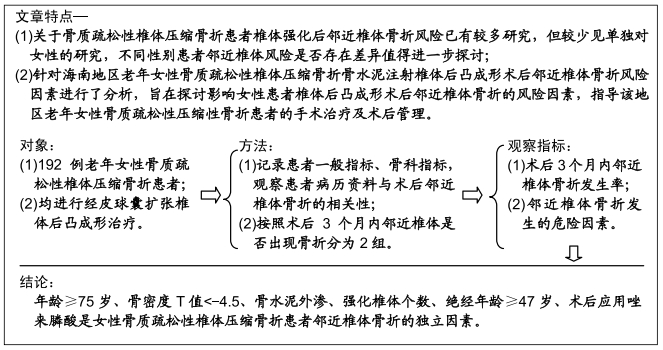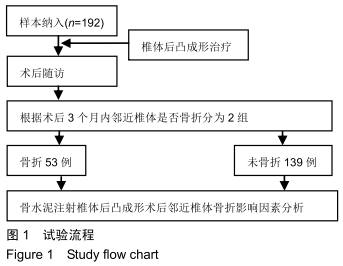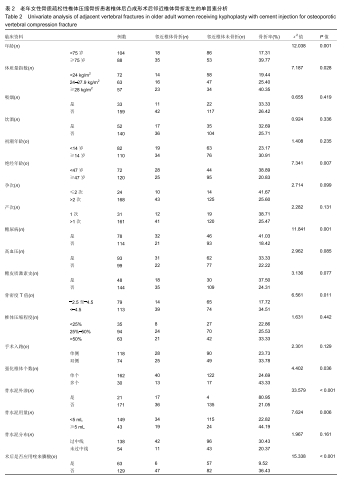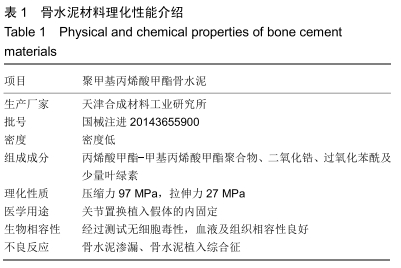[1] 马冬亮,高红琴,朱侃,等.中国苏州地区老年女性中骨质疏松症危险因素的筛选[J].中国骨质疏松杂志,2018,24(12):1634-1639.
[2] 陈军平,齐新文,李松军,等.椎体注射骨水泥强化治疗骨质疏松性胸腰椎体压缩骨折[J].中国组织工程研究,2015,19(21): 3292-3296.
[3] 刘长迎.经皮椎体成形术对老年骨质疏松性胸腰椎压缩性骨折患者Cobb角、椎体前缘高度变化的影响[J].中国老年学杂志, 2015,35(12):3349-3350.
[4] ABDELRAHMAN H, SIAM AE, SHAWKY A, et al.Infection after vertebroplasty or kyphoplasty.A series of nine cases and review of literature.Spine J.2013;13:1809-1817.
[5] 陈涛,杨建东,张亮,等.骨质疏松性胸腰椎骨折椎体强化术后发生邻近椎体骨折的危险因素分析[J].骨科,2017,8(3):190-193,199.
[6] TAN WL, LOW SL, SHEN L, et al.Osteoporotic hip fractures: 10-year review in a Singaporean hospital.J Orthop Surg(Hong Kong).2015;23(2):150-154.
[7] YI X, LU H, TIAN F, et al.Recompression in new levels after percutaneous vertebroplasty and kyphoplasty compared with conservative treatment.Arch Orthop Trauma Surg. 2014; 134(1):21-30.
[8] 郭勇.骨质疏松性椎体压缩性骨折经皮椎体成形术治疗对患椎邻近椎体退变和骨折的影响[J].实用临床医药杂志, 2016, 20(19):93-94.
[9] MAZZANTINI M, CARPEGGIANI P, D'ASCANIO A, et al. Long-term prospective study of osteoporotic patients treated with percutaneous vertebroplasty after fragility fractures. Osteoporos Int.2011;22(5):1599-1607.
[10] MUDANO AS, BIAN J, COPE JU, et al.Vertebroplasty and kyphoplasty are associated with an increased risk of secondary vertebral compression fractures: a population-based cohort stud.Osteoporos Int. 2009;20(5):819-826.
[11] LAVELLE WF, CHENEY R.Recurrent fracture after vertebral kyphoplasty.Spine J. 2006;6(5):488-493.
[12] SCHULTE TL, KEILER A, RIECHELMANN F, et al. Biomechanical comparison of vertebral augmentation with silicone and PMMA cement and two filling grades.Eur Spine J.2013;22(12):2695-2701.
[13] 边平达,陈锦平.80岁以上高龄老年骨质疏松症的规范诊治和注意事项[J].中国骨质疏松杂志,2015,21(6):757-760,768.
[14] TAKAHARA K, KAMIMURA M, MORIYA H, et al.Risk factors of adjacent vertebral collapse after percutaneous vertebroplasty for osteoporotic vertebral fracture in postmenopausal women. BMC Musculoskelet Disord.2016;17:12.
[15] 刘伟.经皮椎体成形术治疗骨质疏松性胸腰段脊柱骨折后邻近椎体再骨折的危险因素分析[J].解放军医药杂志, 2017,29(12): 53-56.
[16] ZHAI W, JIA Y, WANG J, et al.The clinical effect of percutaneous kyphoplasty for the treatment of multiple osteoporotic vertebral compression fractures and the prevention of new vertebral fractures.Int J Clin Exp Med. 2015; 8(8):13473-13481.
[17] 吴健,关月红,范胜利.单节段胸腰段骨折经皮后凸成形术后再骨折的风险因素分析[J].中国骨伤,2017,30(9):833-837.
[18] 吴鹏,王博,刘康,等.唑来膦酸钠对高转换患者椎体成形术后椎体再骨折发生率影响因素的相关性分析[J].中国骨质疏松杂志, 2017,23(8):1075-1080.
[19] ZHANG Z, FAN J, DING Q, et al.Risk factors for new osteoporotic vertebral compression fractures after vertebroplasty: a systematic review and meta-analysis.J Spinal Disord Tech.2013;26(4):E150-157.
[20] DEIBERT CP, GANDHOKE GS, PASCHEL EE, et al.A Longitudinal cohort Investigation of the development of symptomatic adjacent level compression fractures following balloon-assisted kyphoplasty in a series of 726 patients.Pain Physician.2016;19(8):E1167-E1172.
[21] 张鹭,吴军,路锟,等.经皮椎体成形术治疗老年骨质疏松椎体压缩性骨折术后邻近椎体骨折的相关危险因素[J].中国老年学, 2015, 35(16):4612-4614.
[22] KRITZ-SILVERSTEIN D, BARRETT-CONNOR E.Early menopause, number of reproductive years, and bone mineral density in postmenopausal women.Am J Public Health. 1993; 83:983-988.
[23] GAMBACCIANI M, SPINETTI A, DE SIMONE L, et al.The relative contributions of menopause and aging to postmenopausal vertebral osteopenia.J Clin Endocrinol Metab.1993;77:1148-1151.
|




